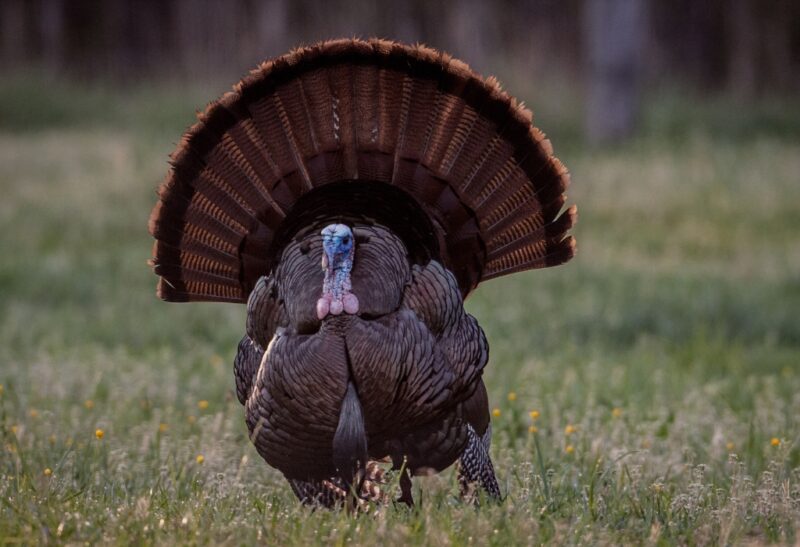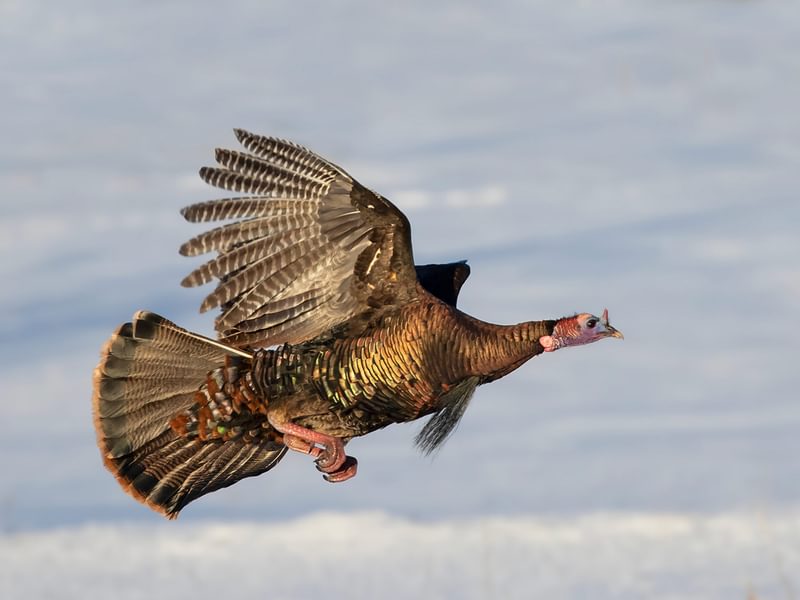Wild turkeys are often misunderstood when it comes to their flying abilities. Many people assume these birds cannot fly because of their large size and ground-dwelling habits. However, the truth is far more intriguing. Wild turkeys possess remarkable flying skills that play a crucial role in their survival and daily lives. In this article, we will explore the fascinating world of wild turkeys and uncover the secrets behind their aerial capabilities.
While domestic turkeys have lost much of their ability to fly due to selective breeding, wild turkeys remain agile and powerful fliers. Their ability to take to the skies helps them evade predators, travel long distances, and find food. Understanding how and why wild turkeys fly is essential for appreciating their unique adaptations and ecological role.
This comprehensive guide will delve into the science behind wild turkey flight, their physical adaptations, and the importance of flying in their daily lives. Whether you're a nature enthusiast or simply curious about these remarkable birds, this article will provide you with all the information you need to understand their flying abilities fully.
Read also:Cynthia Erivo In Greatest Showman The Ultimate Exploration Of Talent And Dedication
Table of Contents
- Introduction to Wild Turkeys
- Physical Characteristics of Wild Turkeys
- Can Wild Turkeys Fly?
- Flight Mechanics of Wild Turkeys
- Flight Speed and Distance
- Why Wild Turkeys Fly
- Predator Avoidance through Flight
- Roosting Habits and Flight
- Myths and Misconceptions about Wild Turkey Flight
- Conservation Efforts and Wild Turkey Flight
Introduction to Wild Turkeys
Wild turkeys (Meleagris gallopavo) are native to North America and are one of the most iconic birds in the region. These large, ground-dwelling birds are known for their striking plumage, distinctive calls, and social behaviors. Despite their size, wild turkeys are highly adaptable and thrive in a variety of habitats, from forests to grasslands.
One of the most common misconceptions about wild turkeys is that they cannot fly. This belief likely stems from their domesticated cousins, which have been bred for meat production and have lost much of their ability to take to the skies. However, wild turkeys are not only capable of flying but are also skilled at it. Their flight abilities are a vital part of their survival strategy.
Understanding the biology and behavior of wild turkeys is essential for appreciating their flying abilities. In the following sections, we will explore the physical characteristics, flight mechanics, and ecological significance of wild turkey flight.
Physical Characteristics of Wild Turkeys
Wild turkeys possess several physical adaptations that make them excellent fliers. Their large wingspan, strong muscles, and lightweight bones are all crucial for sustained flight. On average, wild turkeys weigh between 8 and 18 pounds, with males (toms) being larger than females (hens).
Wingspan and Feather Structure
The wingspan of a wild turkey can reach up to 4-5 feet, providing them with the lift necessary for flight. Their feathers are specially adapted for aerodynamics, with stiff, broad feathers on the wings and tail that help them maintain balance and control during flight.
Muscular Structure
Wild turkeys have powerful flight muscles, particularly in their chest and shoulders. These muscles account for a significant portion of their body weight and enable them to generate the energy needed for rapid takeoffs and short bursts of flight.
Read also:Transform Your Space Discover The Art Of Cuartos Bonitos
Additionally, their lightweight bones help reduce the energy required for flight. Unlike domestic turkeys, whose bones are denser due to selective breeding, wild turkeys have hollow bones that make them more efficient fliers.
Can Wild Turkeys Fly?
Yes, wild turkeys can fly, and they do so quite effectively. While they are not built for long-distance migrations like some bird species, wild turkeys are capable of short, powerful flights that serve several important purposes. Their ability to fly allows them to escape predators, reach food sources, and find safe roosting spots.
Wild turkeys typically fly in short bursts, covering distances of up to a quarter of a mile in a single flight. They can reach heights of 50-100 feet, which is sufficient for evading most ground predators. This ability is particularly important during the night, when they roost in trees to avoid nocturnal hunters.
It's worth noting that wild turkeys prefer walking or running when possible, as flying requires significant energy. However, when threatened or in need of quick transportation, they rely on their flying abilities to ensure their safety.
Flight Mechanics of Wild Turkeys
The flight mechanics of wild turkeys involve a combination of flapping and gliding. Their powerful wing muscles allow them to generate rapid, forceful flaps, which propel them into the air. Once airborne, they can glide short distances using their broad wings for stability.
Takeoff and Landing
Wild turkeys are experts at taking off quickly from the ground. They use their strong legs to leap into the air, giving them an initial boost before their wings take over. This rapid takeoff is essential for escaping predators and reaching tree branches for roosting.
Landing is equally important, and wild turkeys are adept at controlling their descent. They use their wings to slow down and adjust their position before touching down on a branch or the ground. This precision ensures they can land safely in even the most challenging environments.
Flight Speed and Distance
Wild turkeys are surprisingly fast fliers for their size. They can reach speeds of up to 55 miles per hour during short bursts of flight. This speed is crucial for evading predators and covering short distances quickly.
In terms of distance, wild turkeys typically fly between 100 and 200 yards per flight. While this may not seem like much compared to migratory birds, it is sufficient for their needs. Their flight range allows them to move between feeding areas, roosting sites, and safe havens as needed.
Factors Affecting Flight Performance
Several factors can influence the flight performance of wild turkeys, including weather conditions, terrain, and individual health. For example, strong winds or heavy rain may limit their ability to fly effectively. Similarly, older or injured birds may not be able to fly as far or as fast as younger, healthier individuals.
Why Wild Turkeys Fly
Wild turkeys fly for a variety of reasons, each of which plays a crucial role in their survival. The primary reasons include:
- Predator Avoidance: Flying allows wild turkeys to escape predators such as coyotes, foxes, and birds of prey.
- Roosting: Wild turkeys roost in trees at night to avoid ground-based predators.
- Feeding: Flying helps wild turkeys access food sources that may be difficult to reach on foot.
- Mating: During the breeding season, male turkeys may fly to attract mates or establish dominance.
Each of these reasons highlights the importance of flight in the daily lives of wild turkeys. By understanding why they fly, we gain insight into their behavior and ecological role.
Predator Avoidance through Flight
One of the most critical functions of wild turkey flight is predator avoidance. These birds face numerous threats in the wild, from terrestrial predators like coyotes and bobcats to aerial predators such as hawks and eagles. Their ability to take to the skies provides them with a significant advantage in evading these dangers.
When threatened, wild turkeys use their powerful legs to leap into the air, followed by rapid wing flaps to gain altitude quickly. This combination of speed and agility allows them to outmaneuver many predators. Once airborne, they can glide to safety or land in a nearby tree for further protection.
Case Studies and Research
Research has shown that wild turkeys are highly effective at using flight to evade predators. Studies conducted in various habitats have demonstrated that turkeys are more likely to survive in areas where they have access to tall trees for roosting and open spaces for takeoff and landing.
Roosting Habits and Flight
Roosting is an essential part of wild turkey behavior, and flight plays a crucial role in this process. At night, wild turkeys roost in trees to avoid ground-based predators. Their ability to fly allows them to reach these elevated perches safely and efficiently.
Roosting sites are typically chosen based on factors such as tree height, branch structure, and proximity to food sources. Wild turkeys prefer tall trees with sturdy branches that can support their weight. They also tend to roost in groups, which provides additional protection against predators.
Seasonal Variations
Roosting habits may vary depending on the season. During the breeding season, male turkeys may roost separately from females to establish territories and attract mates. In winter, turkeys may roost closer to food sources to conserve energy.
Myths and Misconceptions about Wild Turkey Flight
There are several myths and misconceptions surrounding wild turkey flight, many of which stem from confusion with domestic turkeys. One of the most common myths is that wild turkeys cannot fly at all. As we have seen, this is far from the truth. Wild turkeys are skilled fliers, capable of impressive feats of aerial agility.
Another misconception is that wild turkeys only fly during emergencies. While it is true that they prefer walking or running when possible, wild turkeys use flight regularly for roosting, feeding, and mating. Understanding these behaviors helps dispel the myth that they are clumsy or flightless birds.
Conservation Efforts and Wild Turkey Flight
Conservation efforts play a vital role in protecting wild turkey populations and preserving their natural habitats. Organizations such as the National Wild Turkey Federation work to restore and enhance turkey habitats, ensuring that these birds have access to the resources they need to thrive.
Flight is an essential component of wild turkey conservation. By maintaining open spaces for takeoff and landing and preserving tall trees for roosting, conservationists help ensure that wild turkeys can continue to use their flying abilities effectively. These efforts not only benefit wild turkeys but also support the broader ecosystem by promoting biodiversity and habitat health.
Collaborative Initiatives
Collaborative initiatives between government agencies, non-profit organizations, and private landowners are crucial for successful conservation. These partnerships enable the implementation of large-scale projects that address the needs of wild turkeys and other wildlife species.
Conclusion
In conclusion, wild turkeys are far more capable fliers than many people realize. Their ability to take to the skies plays a crucial role in their survival, enabling them to evade predators, access food sources, and find safe roosting spots. By understanding the biology, behavior, and ecological significance of wild turkey flight, we gain a deeper appreciation for these remarkable birds.
We invite you to share your thoughts and experiences with wild turkeys in the comments below. Have you ever witnessed a wild turkey in flight? What did you find most impressive about their abilities? Your feedback helps us create more informative and engaging content for nature enthusiasts like you. Thank you for reading, and don't forget to explore our other articles on wildlife and conservation topics!


